Thursday, 23 May 2013: Orange
Written Sunday, 9 June 2013
The plan for Thursday was a day-trip to Orange, mainly to see the Théatre Antique, the only Roman theater in Europe (and one of only three in the world) with its scene wall still standing. As usual, I was up earlier than the others, so I took the opportunity to drop by the OT to ask about river cruises. Unfortunately, the answer was that, yes, there were some 2- and 3-hour tours, but no, they were not running because it had been raining a lot upstream and the river was too high. So much for that. I think this year's trip sets a record for most closed museums, cancelled boat rides, and otherwise unavailable attractions.
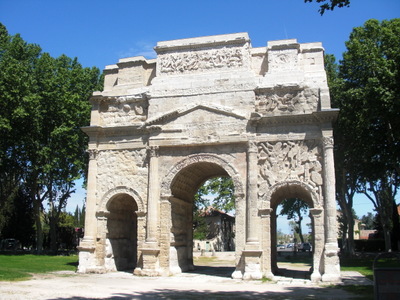
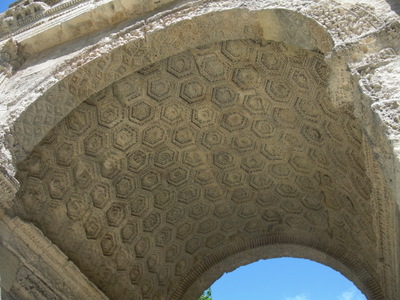 We had agreed to meet in the lobby at 11 a.m., so as to have lunch in Orange, but Jeff came down to say that CJ wasn't feeling well. He opted to stay with her, so David and I set off alone. I had checked out parking on the internet and found plenty of possibilities, but we found the ample lots by the Office de Tourisme filled, half of each lot with the weekly market and the other half with the cars of shoppers at the weekly market. We therefore kept on going, headed for another parking lot I had spotted on the other side of town, but before we got there, we found space in a lot next to the arc de triomphe.
We had agreed to meet in the lobby at 11 a.m., so as to have lunch in Orange, but Jeff came down to say that CJ wasn't feeling well. He opted to stay with her, so David and I set off alone. I had checked out parking on the internet and found plenty of possibilities, but we found the ample lots by the Office de Tourisme filled, half of each lot with the weekly market and the other half with the cars of shoppers at the weekly market. We therefore kept on going, headed for another parking lot I had spotted on the other side of town, but before we got there, we found space in a lot next to the arc de triomphe.
Orange was founded in 35 B.C. by discharged members of the second Gallic legion, and the arc was built outside the city walls during the 1st century A.D., as a show of power and a commemoration of their exploits, so it ws never a gate or part of a larger wall. Its elaborate decoration has won it the status of a UNESCO World Heritage site. The Princes of Orange reworked it into a defensive tower during the middle ages, but it was restored to its original form during the great French surge of historical restorations of the 19th century.
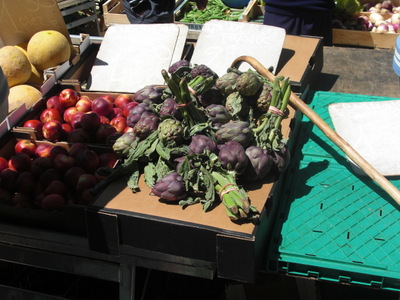
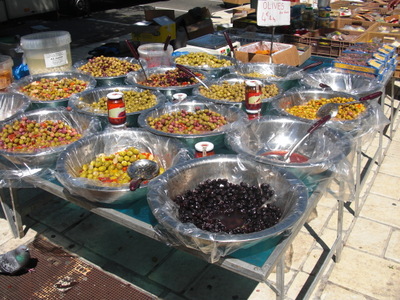 On our way back toward lunch, we walked the length of the market—always fun, even though this market seemed less "spontaneous" than the usual. I think it was geared a little more toward tourists than a market in a less tourism-intensive town.
On our way back toward lunch, we walked the length of the market—always fun, even though this market seemed less "spontaneous" than the usual. I think it was geared a little more toward tourists than a market in a less tourism-intensive town.
On the left, a heap of small purple artichokes, tied into 9-euro bundles. On the right, a stand selling many kinds of olives (4 euros/kg, mix and match). Around the edges of the display were boxes of dates, still in clusters on the stems, and jars of pickled garlic and salt-preserved lemons. Interspersed among the bowls, jars of hot pepper sauce.
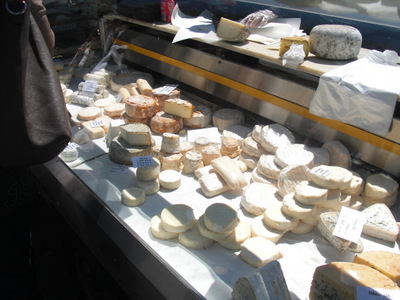
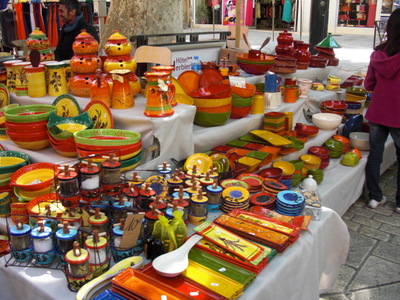 On the left here is a lovely (and tempting) display of small cheeses, mostly made from goat and sheep's milk, including a goat-cheese blue. Another display included only large, dry, aged cheeses, in wheels from 10 to 30 lb.: Cantal, Comté, Beaufort, Tome de Chèvre, Abondance Fermière, and Pur Brebis.
On the left here is a lovely (and tempting) display of small cheeses, mostly made from goat and sheep's milk, including a goat-cheese blue. Another display included only large, dry, aged cheeses, in wheels from 10 to 30 lb.: Cantal, Comté, Beaufort, Tome de Chèvre, Abondance Fermière, and Pur Brebis.
On the right a display of brightly colored Provençal stoneware. It was mostly for tourists, I think, but we've sometimes been served restaurant food in dishes like these, especially small bowls of olives and such.
In the display of a used-book seller, David found a volume he was interested in and was prepared to pay the 6 euros for it on the spot, but the merchant explained that it was part of a four-volume set—would he like the whole thing? David said he would, but the books were back in the merchant's van. We agreed to come back in an hour, when the market would be ending and he could go back for the others. Unfortunately, we were about 10 minutes late getting back, and he had packed up and gone, so he didn't even make the 6-euro sale.
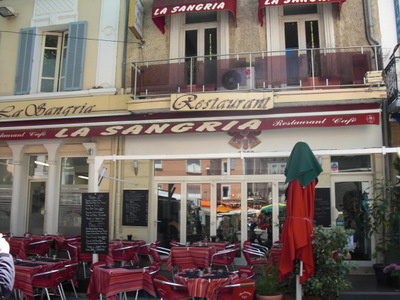
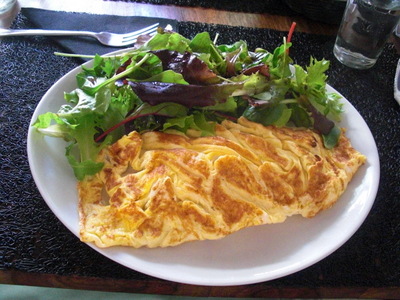 When we turned from the peripheral market into the center of town in search of lunch, we found that the market continued there, lining many of the streets, and included more meat, seafood, and baked goods. As usual, it was hard to walk past those sidewalk rotisseries selling hot, freshly roasted chickens.
When we turned from the peripheral market into the center of town in search of lunch, we found that the market continued there, lining many of the streets, and included more meat, seafood, and baked goods. As usual, it was hard to walk past those sidewalk rotisseries selling hot, freshly roasted chickens.
We settled for lunch at La Sangria and both had "compagnard" omelets, filled with bacon, cheese, and potatoes. Salad on the side. Still haven't managed to find a really good omelet. The best ever remains the one I got at Rendezvous Provençal in, no, not Provence, but Bath, England.
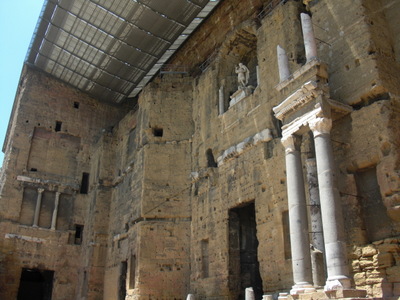
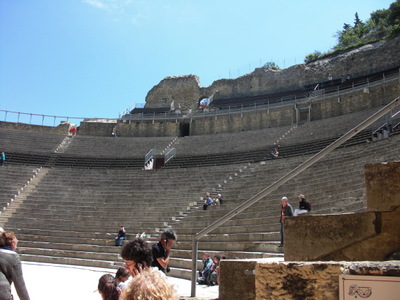 Next up was our visit to the famous theater. The price of the admission ticket included both an excellent audioguide and admission to the city museum across the street. On the left is part of the scene wall. Note the large statue of Caesar high up in the center. It was a general policy of the Roman empire that you could worship anything or anybody you wanted so long as you also worshiped the emperor. (That was where the Christians ran into trouble; they wouldn't.) So every large public edifice in the empire featured a statue of the emperor, just as American ones always have a flag somewhere. The heads on the statues screwed on and off, and a special facility in Rome mass-produced them so that, when one emperor succeeded another, new heads could be shipped out to all the provinces to replace the old ones. The theater was built under Augustus, but I don't know whose head is on the statue now.
Next up was our visit to the famous theater. The price of the admission ticket included both an excellent audioguide and admission to the city museum across the street. On the left is part of the scene wall. Note the large statue of Caesar high up in the center. It was a general policy of the Roman empire that you could worship anything or anybody you wanted so long as you also worshiped the emperor. (That was where the Christians ran into trouble; they wouldn't.) So every large public edifice in the empire featured a statue of the emperor, just as American ones always have a flag somewhere. The heads on the statues screwed on and off, and a special facility in Rome mass-produced them so that, when one emperor succeeded another, new heads could be shipped out to all the provinces to replace the old ones. The theater was built under Augustus, but I don't know whose head is on the statue now.
The roof in place now is modern, of course, but the scene wall would originally have had a roof in the same position. It's hard to see in this photo, but the last few courses of stones below the ceiling have a reddish tinge—the result of overheating of the stone when the original wooden roof burned. Like all the other theaters and amphitheaters we've toured, it was at one time built over—not buried, but just covered with houses, inside and out—and was only emptied out again in the 19th century.
The photo on the right shows part of the seats, which originally could accommodate about 9000 spectators. Some of the stone risers, which were particularly damaged, have been restored, and in other places, modern bleachers replace sections where the stone seats are gone. The place was full of tourists wandering from audioguide number to audioguide number, and a surprising number were listening and conversing in Dutch. The Dutch arrive in busloads to tour Orange, because their royal family is the House of Orange-Nassau, and this is the Orange that William of Orange (William I of the Netherlands, founder of the dynasty and incidentally of the Netherlands itself) was from. The other William of Orange (William III of the Netherlands and grandson, I think, of William I) was the William of William and Mary, who jointly ruled Engand in the late 17th century. (He was also William III of England, but only William II of Scotland.) He was also from here.
Adjacent to the theater (and also included in the same admission) are the ruins of a large temple complex—mainly the floors and lower few stones of the walls.
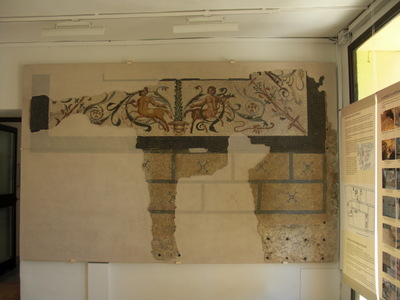
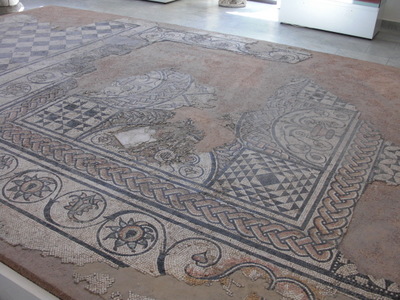 The museum across the street was small but varied and interesting. On the left here is a fragment of a mosaic wall and on the right most of a mosaic floor, both from Roman times.
The museum across the street was small but varied and interesting. On the left here is a fragment of a mosaic wall and on the right most of a mosaic floor, both from Roman times.
Around them were many fragments of statuary and other decorative stone work salvaged from ruins around the town, as well as painting, silver, and other art and objects from more recent centuries. One section was about fabric printing and included a reconstruction of a printer's shop and several of the carved blocks (about a foot square) used to print repetitive patterns. The patterns and the printing methods were originally brought to Marseille from India and were often paisley-based, but more and more the motifs have been replaced with patterns based on Provençal themes, like olives, fruit, tomatoes, and sunflowers.
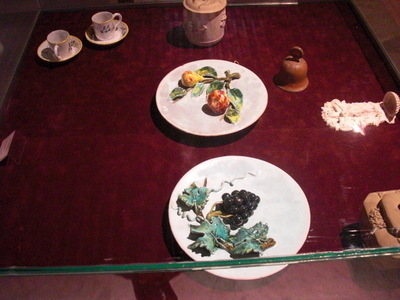
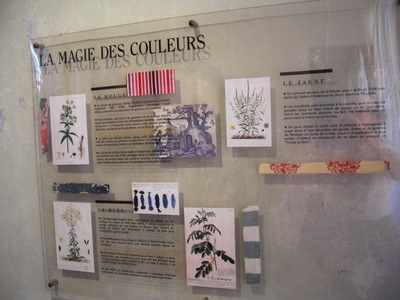 These faiance dishes were among the exhibits. The grapes and fruit are actually part of the plates.
These faiance dishes were among the exhibits. The grapes and fruit are actually part of the plates.
I also really liked this panel explaining the sources of the plant-based dyes used in the fabric-printing process. They are, of course, the same ones we were introduced to in Normandy, a propos of the Bayeux Tapestry and near Toulouse, where woad used to be a major crop.
The source of red was the root of "garance," madder (Rubia tinctorum, Rubiaceae, upper left). Yellow came from "gaude," dyer's rocket (Reseda luteola, Resedaceae, upper right). Blue originally came from "pastel," woad (Isatis tinctoria, Brassicaceae), but that species was later replaced by indigo (Indigofera tinctoria, Fabaceae, lower left and right).
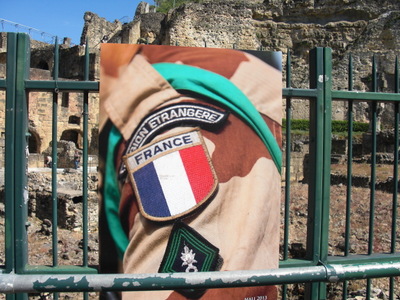
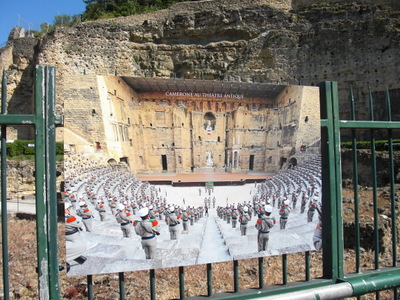 Leaving the museum, we were drawn to a set of large photographs mounted on the outside of the fence surrounding the ruined temple complex. It seems that 1st (and only) cavalry regiment of the French Foreign Legion is based in Orange, and the photographs show scenes from its service from the 1920's to the present, including their tanks and rocket launchers in Afghanistan.
Leaving the museum, we were drawn to a set of large photographs mounted on the outside of the fence surrounding the ruined temple complex. It seems that 1st (and only) cavalry regiment of the French Foreign Legion is based in Orange, and the photographs show scenes from its service from the 1920's to the present, including their tanks and rocket launchers in Afghanistan.
At the left is a close-up of their shoulder insignia. Others included an aerial view of a group of members of the regiment standing on the deck of an aircraft carrier in a formation in the shape of the mark within the black diamond you can see in the photo here.
On the right is a photo of the regiment formed up in the theater in Orange on the anniversary of the Battle of Camerone (Mexico, 1863), in which a small Foreign Legion unit fought almost to the last man (the last five guys ran out of ammunition and charged with fixed bayonets, but their opposing commander ceased fire and spared them). Good view of the scene wall.
On the way back to the car we passed a plaque commemorating the high-water mark of the great flood of September 1924 (which was about 3 inches over David's head). We also saw a statue of Rimbaud II d'Orange, a count of Orange who won great victories at Antioch and Jerusalem around 1099 during the crusades. Note that "Rimbaud" is pronounced "Rambo" and is probably the original spelling of that name in North America.
On the way back to Avignon, we stopped for gas at an old-fashioned, thoroughly nonautomated service station, where our credit card was bound to be good (it was). It was the first fuel we'd bought since we picked up the car, and we only put in 15 euros' worth, because that might be enough for the rest of the trip. The car gets terrific milage.
We got back to the hotel in Avignon to find Jeff and CJ out, a good sign. Sure enough, they got back about 20 minutes later, and CJ was feeling much better. They had walked back up to the top of the Rocher des Doms to admire the view and explore the park.
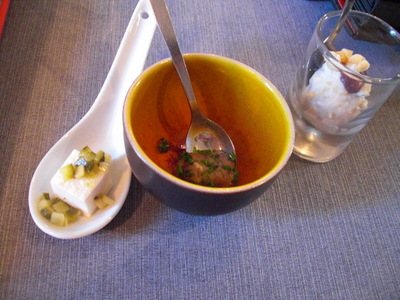
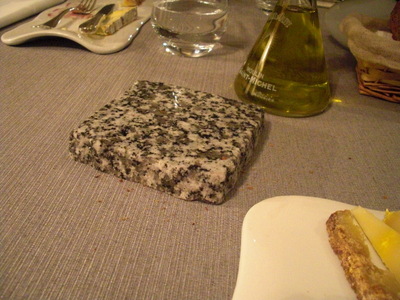 For dinner, we walked to Christian Etienne, the restaurant near the palace behind which I had seen the young cooks playing soccer. We ordered the "Palace Menu," so we ate all the same things (barring modifications for CJ).
For dinner, we walked to Christian Etienne, the restaurant near the palace behind which I had seen the young cooks playing soccer. We ordered the "Palace Menu," so we ate all the same things (barring modifications for CJ).
The first amuse-bouche, which we were advised to eat left to right, consisted of a cube of cheese with stewed dice of zucchini, a bit of fish tartare with chives, and a brandade de morue (I think).
On the right is my bread plate. Each of us got a similar slab of granite, adnd they weren't very useful—we were given a nice bottle of olive oil to put on our bread, but the granite slabs had no hint of a rim, so any drops that escaped wound up on the tablecloth.
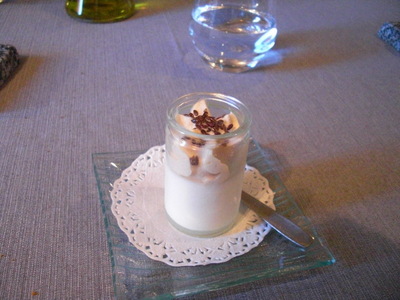
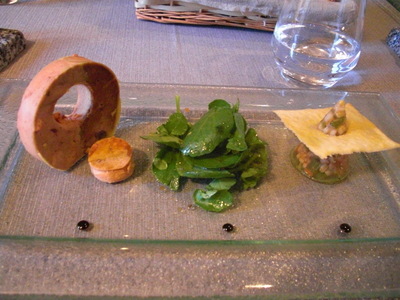 The second amuse-bouche was a cold soup of celery root with langoustine fluff and a sprinkle of flax seeds. Delicious! CJ isn't allergic to flax seeds, but the kitchen was taken no chances and left them off her portion.
The second amuse-bouche was a cold soup of celery root with langoustine fluff and a sprinkle of flax seeds. Delicious! CJ isn't allergic to flax seeds, but the kitchen was taken no chances and left them off her portion.
First course: Aspic of duck foie gras and spelt (from the Sault region), with a cress salad and balsamique vinaigrette. The foie gras was moulded into a cylinder, and each of us was served a slice with the center punched out. The aspic of spelt was moulded into a cone, and a fragile square house-made cracker with a circle punched out of the center was laid gently over it.
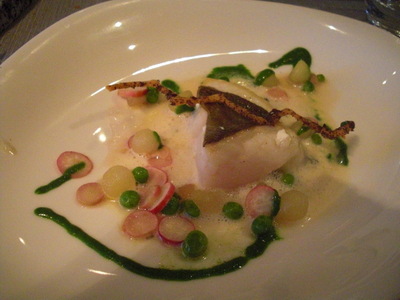
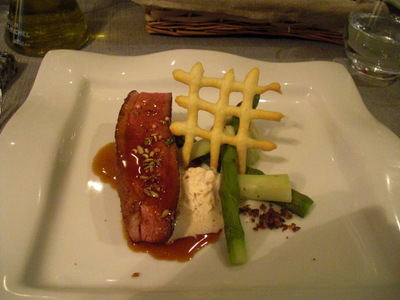 Second course: Filet of Saint-Pierre (Zeus faber, John Dory) sautéed in olive oil, "springtime marbles" (peas, which are already marble-shaped, and potatoes cut to the same size and shape with a melon-baller; the little radishes were just sliced), broth of fish bones, and raw algae.
Second course: Filet of Saint-Pierre (Zeus faber, John Dory) sautéed in olive oil, "springtime marbles" (peas, which are already marble-shaped, and potatoes cut to the same size and shape with a melon-baller; the little radishes were just sliced), broth of fish bones, and raw algae.
Third course: Rosy grilled duck breast, asparagus both whole and in a custard timbale, and emulsion of hazelnuts (left off CJ's portion, of course). The cross-hatch object is a sort of cracker made of crêpe batter, and the duck was sprinkled with "pan masala," the mixture of seeds often served at the end of an Indian meal.
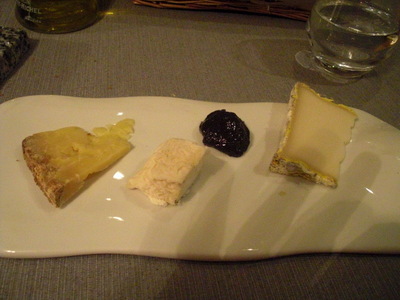
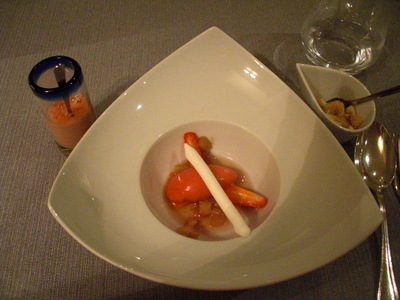 Cheese: The cheese trolley was another good one. I had (left to right) another good Salers, a semidry chevre, and a tomme de Brebis, with a dab of black-cherry jam. David was able to get an excellent Roquefort. This trip was Jeff's first experience of cheese trolleys, and I think he considers them a very good thing. He was quite adventurous in his choices and didn't seem to get anything he didn't like.
Cheese: The cheese trolley was another good one. I had (left to right) another good Salers, a semidry chevre, and a tomme de Brebis, with a dab of black-cherry jam. David was able to get an excellent Roquefort. This trip was Jeff's first experience of cheese trolleys, and I think he considers them a very good thing. He was quite adventurous in his choices and didn't seem to get anything he didn't like.
First dessert: strawberries and rhubarb dice in syrup with strawberry sorbet, a very sweet strawberry emulsion, cookie crumbles, and a crisp meringue stick.
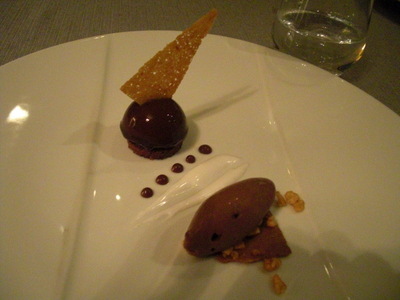
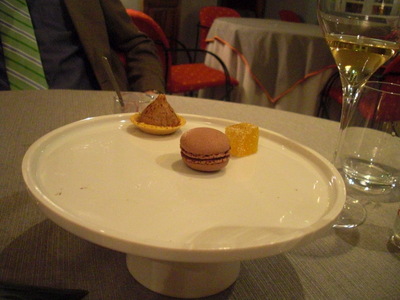 Second dessert: various chocolate creams, sauces, mousses, and cookies. CJ got a different assortment because some of the items on our plates had nuts in or under them.
Second dessert: various chocolate creams, sauces, mousses, and cookies. CJ got a different assortment because some of the items on our plates had nuts in or under them.
Mignardises: Apricot fruit paste, tiny chocolate tarts, and filled macaroons.
One of the nice things about the location of our hotel in Avignon is that the walk back from the restaurant was always downhill. It also led back along the lively and picturesque Rue de la République, where we could continue our people watching all the way back.
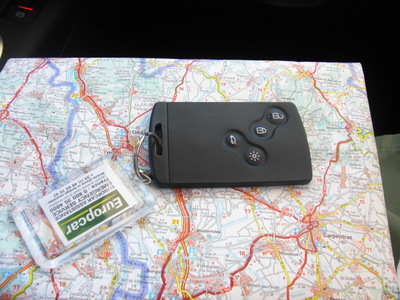 Finally, here's a photo of the key to our rental car, which I got a chance at while David pumped the gas.
Finally, here's a photo of the key to our rental car, which I got a chance at while David pumped the gas.
previous entry
List of Entries
next entry

 We had agreed to meet in the lobby at 11 a.m., so as to have lunch in Orange, but Jeff came down to say that CJ wasn't feeling well. He opted to stay with her, so David and I set off alone. I had checked out parking on the internet and found plenty of possibilities, but we found the ample lots by the Office de Tourisme filled, half of each lot with the weekly market and the other half with the cars of shoppers at the weekly market. We therefore kept on going, headed for another parking lot I had spotted on the other side of town, but before we got there, we found space in a lot next to the arc de triomphe.
We had agreed to meet in the lobby at 11 a.m., so as to have lunch in Orange, but Jeff came down to say that CJ wasn't feeling well. He opted to stay with her, so David and I set off alone. I had checked out parking on the internet and found plenty of possibilities, but we found the ample lots by the Office de Tourisme filled, half of each lot with the weekly market and the other half with the cars of shoppers at the weekly market. We therefore kept on going, headed for another parking lot I had spotted on the other side of town, but before we got there, we found space in a lot next to the arc de triomphe.
 On our way back toward lunch, we walked the length of the market—always fun, even though this market seemed less "spontaneous" than the usual. I think it was geared a little more toward tourists than a market in a less tourism-intensive town.
On our way back toward lunch, we walked the length of the market—always fun, even though this market seemed less "spontaneous" than the usual. I think it was geared a little more toward tourists than a market in a less tourism-intensive town.
 On the left here is a lovely (and tempting) display of small cheeses, mostly made from goat and sheep's milk, including a goat-cheese blue. Another display included only large, dry, aged cheeses, in wheels from 10 to 30 lb.: Cantal, Comté, Beaufort, Tome de Chèvre, Abondance Fermière, and Pur Brebis.
On the left here is a lovely (and tempting) display of small cheeses, mostly made from goat and sheep's milk, including a goat-cheese blue. Another display included only large, dry, aged cheeses, in wheels from 10 to 30 lb.: Cantal, Comté, Beaufort, Tome de Chèvre, Abondance Fermière, and Pur Brebis. 
 When we turned from the peripheral market into the center of town in search of lunch, we found that the market continued there, lining many of the streets, and included more meat, seafood, and baked goods. As usual, it was hard to walk past those sidewalk rotisseries selling hot, freshly roasted chickens.
When we turned from the peripheral market into the center of town in search of lunch, we found that the market continued there, lining many of the streets, and included more meat, seafood, and baked goods. As usual, it was hard to walk past those sidewalk rotisseries selling hot, freshly roasted chickens.
 Next up was our visit to the famous theater. The price of the admission ticket included both an excellent audioguide and admission to the city museum across the street. On the left is part of the scene wall. Note the large statue of Caesar high up in the center. It was a general policy of the Roman empire that you could worship anything or anybody you wanted so long as you also worshiped the emperor. (That was where the Christians ran into trouble; they wouldn't.) So every large public edifice in the empire featured a statue of the emperor, just as American ones always have a flag somewhere. The heads on the statues screwed on and off, and a special facility in Rome mass-produced them so that, when one emperor succeeded another, new heads could be shipped out to all the provinces to replace the old ones. The theater was built under Augustus, but I don't know whose head is on the statue now.
Next up was our visit to the famous theater. The price of the admission ticket included both an excellent audioguide and admission to the city museum across the street. On the left is part of the scene wall. Note the large statue of Caesar high up in the center. It was a general policy of the Roman empire that you could worship anything or anybody you wanted so long as you also worshiped the emperor. (That was where the Christians ran into trouble; they wouldn't.) So every large public edifice in the empire featured a statue of the emperor, just as American ones always have a flag somewhere. The heads on the statues screwed on and off, and a special facility in Rome mass-produced them so that, when one emperor succeeded another, new heads could be shipped out to all the provinces to replace the old ones. The theater was built under Augustus, but I don't know whose head is on the statue now.
 The museum across the street was small but varied and interesting. On the left here is a fragment of a mosaic wall and on the right most of a mosaic floor, both from Roman times.
The museum across the street was small but varied and interesting. On the left here is a fragment of a mosaic wall and on the right most of a mosaic floor, both from Roman times.
 These faiance dishes were among the exhibits. The grapes and fruit are actually part of the plates.
These faiance dishes were among the exhibits. The grapes and fruit are actually part of the plates.
 Leaving the museum, we were drawn to a set of large photographs mounted on the outside of the fence surrounding the ruined temple complex. It seems that 1st (and only) cavalry regiment of the French Foreign Legion is based in Orange, and the photographs show scenes from its service from the 1920's to the present, including their tanks and rocket launchers in Afghanistan.
Leaving the museum, we were drawn to a set of large photographs mounted on the outside of the fence surrounding the ruined temple complex. It seems that 1st (and only) cavalry regiment of the French Foreign Legion is based in Orange, and the photographs show scenes from its service from the 1920's to the present, including their tanks and rocket launchers in Afghanistan.
 For dinner, we walked to Christian Etienne, the restaurant near the palace behind which I had seen the young cooks playing soccer. We ordered the "Palace Menu," so we ate all the same things (barring modifications for CJ).
For dinner, we walked to Christian Etienne, the restaurant near the palace behind which I had seen the young cooks playing soccer. We ordered the "Palace Menu," so we ate all the same things (barring modifications for CJ).
 The second amuse-bouche was a cold soup of celery root with langoustine fluff and a sprinkle of flax seeds. Delicious! CJ isn't allergic to flax seeds, but the kitchen was taken no chances and left them off her portion.
The second amuse-bouche was a cold soup of celery root with langoustine fluff and a sprinkle of flax seeds. Delicious! CJ isn't allergic to flax seeds, but the kitchen was taken no chances and left them off her portion.
 Second course: Filet of Saint-Pierre (Zeus faber, John Dory) sautéed in olive oil, "springtime marbles" (peas, which are already marble-shaped, and potatoes cut to the same size and shape with a melon-baller; the little radishes were just sliced), broth of fish bones, and raw algae.
Second course: Filet of Saint-Pierre (Zeus faber, John Dory) sautéed in olive oil, "springtime marbles" (peas, which are already marble-shaped, and potatoes cut to the same size and shape with a melon-baller; the little radishes were just sliced), broth of fish bones, and raw algae.
 Cheese: The cheese trolley was another good one. I had (left to right) another good Salers, a semidry chevre, and a tomme de Brebis, with a dab of black-cherry jam. David was able to get an excellent Roquefort. This trip was Jeff's first experience of cheese trolleys, and I think he considers them a very good thing. He was quite adventurous in his choices and didn't seem to get anything he didn't like.
Cheese: The cheese trolley was another good one. I had (left to right) another good Salers, a semidry chevre, and a tomme de Brebis, with a dab of black-cherry jam. David was able to get an excellent Roquefort. This trip was Jeff's first experience of cheese trolleys, and I think he considers them a very good thing. He was quite adventurous in his choices and didn't seem to get anything he didn't like.
 Second dessert: various chocolate creams, sauces, mousses, and cookies. CJ got a different assortment because some of the items on our plates had nuts in or under them.
Second dessert: various chocolate creams, sauces, mousses, and cookies. CJ got a different assortment because some of the items on our plates had nuts in or under them.
 Finally, here's a photo of the key to our rental car, which I got a chance at while David pumped the gas.
Finally, here's a photo of the key to our rental car, which I got a chance at while David pumped the gas.